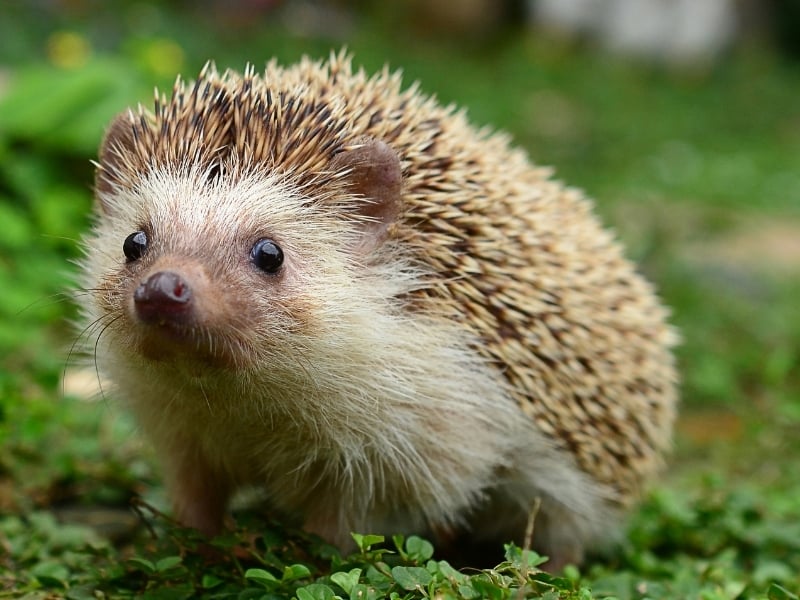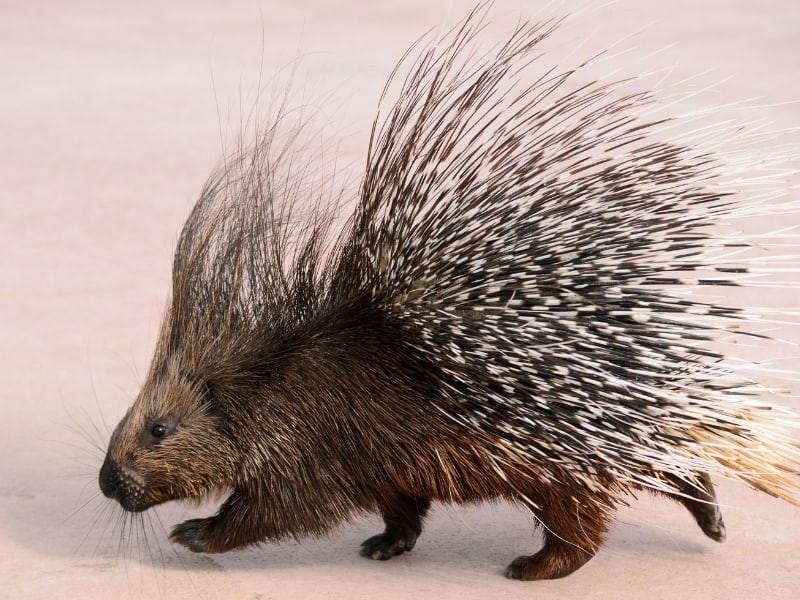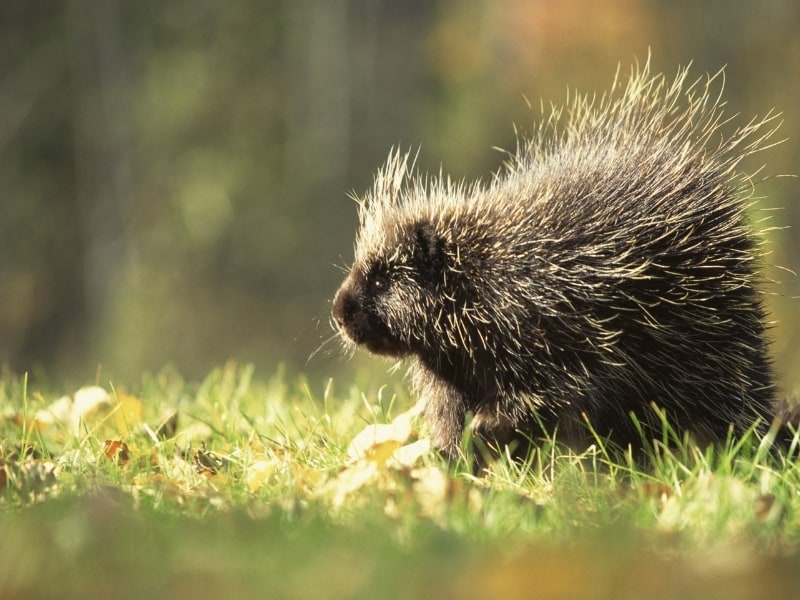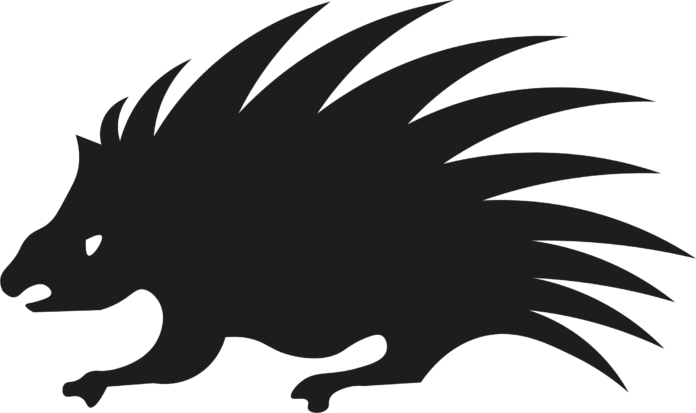Ever come across a spiny little critter and wondered whether it’s a hedgehog or a porcupine?
These exotic creatures are actually interesting pets to have, but you have to know how one differs from the other before choosing which to get.
Comparing a hedgehog vs porcupine is easy. In fact, they have a long list of differences.
Hedgehog vs Porcupine: Difference? Hedgehogs are smaller than porcupines, with quills or spines also shorter than the latter. Hedgehogs’ quills do not fall off, while porcupines’ spines easily attach to any unfortunate predator who dares to come close enough. As to diet, porcupines are herbivores, while hedgehogs are omnivores.
Although porcupines and hedgehogs look very similar, they are not closely related. To better understand their differences and similarities, let’s take a close look at each one.
WHAT IS A HEDGEHOG?

Hedgehogs fall under the animal order Erinaceomorpha and are native to Europe, Asia, and Africa.
There are no species of hedgehogs native to North America and Australia.
The term “hedgehog” comes quite literally, as they are hog-like creatures that frequent hedgerows.
Sometimes also called hedge-pigs, urchins, or furze-pigs, hedgehogs have snouts that resemble those of pigs.
WHAT IS A PORCUPINE?

Porcupines are terrestrial and strictly nocturnal animals classified as large rodents.
Older species of porcupines are native to Europe, Asia, and Africa, while newer species are indigenous to North and South America.
The word “porcupine” comes from the combined Latin words “porcus” and “spina,” which means “pig” and “spine,” respectively.
WHAT IS THE DIFFERENCE BETWEEN HEDGEHOG VS PORCUPINE?

Since they look very similar, how can you differentiate one from the other?
QUILLS OR SPIKES
Both porcupines and hedgehogs have quills, which are also called spines or spikes.
The main difference between them is that hedgehog quills are shorter, measuring only about one inch long. In comparison, porcupine quills can grow as long as three inches.
Hedgehog quills do not fall off during adulthood and are hollow and hardened by keratin. This is the same protein that makes up hair and fingernails in humans.
Young hedgehogs go through a process known as quilling.
In this process, their quills fall off to protect their parents from injuries while nursing them. They grow back up right before they reach adulthood.
This is similar to how human toddlers’ milk teeth fall off to be replaced by permanent teeth.
Although also made of the same protein, the longer quills of porcupines fall off easily and attach to a predator’s skin or fur.
Porcupines have around 30,000 quills, which is way more than the average hedgehog quill count of 5,000.
DEFENSE MECHANISM
Hedgehogs have a very different defensive mechanism compared to that of porcupines. They are mostly prey to owls, badgers, foxes, and wolves.
A hedgehog can roll into a ball to hide all vulnerable extremities from being bitten by any nearby attacker. Until it feels it is out of danger, you can only touch a tight, spiky ball.
On the other hand, a porcupine arches its back while shaking its body and waving its tail to make the spikes fall off easily.
If a porcupine detects danger, it displays a defensive behavior by erecting its spikes and clattering its teeth to make warning noises.
To attack, a porcupine runs sideways or backward in the direction of its attacker. Its sharp quills can impale the predator and can cause injury or even death.
Lynx, bobcats, wolves, coyotes, owls, lions, and fishers are all porcupine predators.
FOOD – HERBIVORE VS CARNIVORE
Traditionally classified under the order Insectivora, hedgehogs are considered carnivores because their diet primarily consists of insects.
Recent observations and studies have proven that hedgehogs are omnivores.
They typically eat insects, frogs, small snakes, bird eggs, and decayed animal flesh. However, they also enjoy berries, grassroots, watermelons, and melons.
On the other hand, porcupines are herbivores, feeding on plants, twigs, berries, and bark.
In some regions, porcupines have a reputation as pests because they also forage farm crops and feed on trees and wooden structures.
LIFESPAN
Porcupines have a longest recorded lifespan of 27 years, while some hedgehogs have lived for 16 years.
On average, both hedgehogs and porcupines in the wild can live for about seven years before a predator gets to them.
Species bred in captivity as pets or in zoos usually live longer because they are protected from these predators.
HIBERNATION
Hedgehogs hibernate for about five to six months from October through April.
During these months, the body temperature of a hedgehog can be as low as 36 degrees Fahrenheit.
Hedgehogs transfer their nest at least once during hibernation. Some are seen out and about during the months of winter.
Porcupines, on the other hand, do not hibernate.
They sleep in for more extended hours during cold months, and they stay close to their dens even when they forage for food.
BEHAVIOR
Both hedgehogs and porcupines are nocturnal creatures. This means they sleep in the day, and they look for food during the night.
Porcupines are both slow-moving and nearsighted.
Unlike other herbivores, which tend to forage in herds or flocks, porcupines are solitary creatures.
They attribute their solitary nature to their capacity for personal defense.
Hedgehogs are also solitary like porcupines, but they sleep for longer hours.
They also rely on smell and hearing to find food because they have very poor eyesight.
BODY SIZE
Although species of hedgehogs have varying sizes, they grow only up to four to 12 inches long.
Porcupines are about three times larger than hedgehogs, and they can grow to be as large as 36 inches.
WHICH IS LARGER: HEDGEHOG OR A PORCUPINE?
Porcupines are longer and larger than hedgehogs.
The smaller porcupine species grow to be about 25 inches long, which is still bigger than the largest hedgehog.
Hedgehogs grow to an average length of only 10 to 12 inches.
The hedgehog is smaller and more manageable than a porcupine, but both have been taken in as pets.
Check state laws in your area if you want one; some states ban hedgehogs and porcupines as pets.
CONCLUSION
The next time you see a spiky creature, don’t panic. Move away at least until you determine whether it’s a porcupine or a hedgehog.
Porcupines are much larger. When in danger, hedgehogs curl into a tight ball, while porcupines start to erect their quills in a defensive position.
If you come across a porcupine, back away calmly and slowly. Also, move your pets far from these critters, as they tend to feel they should attack the porcupine.
If you see a hedgehog and want to relocate it, head on to your tool shed and put on some thick gloves before picking it up.
The best way to handle these creatures is to keep away and call animal services for help.

















![EC Announces Elimination of Indelible Ink in Upcoming Elections [Video]](https://newsonghana.com/wp-content/uploads/2023/12/image-351-218x150.png)






































